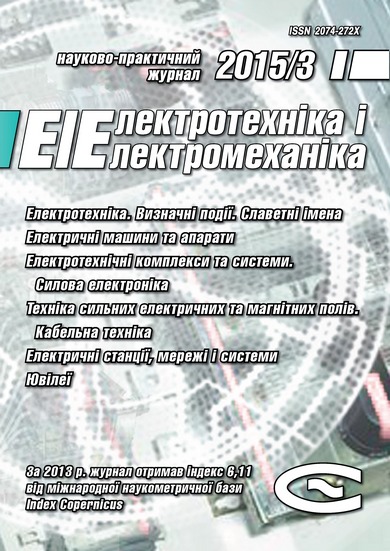POWER FREQUENCY TECHNOGENIC MAGNETIC FIELD REDUCTION BY ACTIVE SCREENING IN SYSTEM SYNTHESIS IN AREA BASED ON STOCHASTIC MULTI-AGENT OPTIMIZATION
DOI:
https://doi.org/10.20998/2074-272X.2015.3.06Keywords:
technogenic magnetic field of power frequency, the system of active screening, synthesis, stochastic multi-agent optimizationAbstract
Purpose. Development of a method of synthesis of systems of active screening of technogenic power frequency magnetic fields within a given region of space, as well as the synthesis and performance evaluation systems synthesized active shielding magnetic field. Methodology. A mathematical model for calculating the components of the magnetic field created by current distributors power line generator or electrical conductors power and control windings magnetic executive bodies on the basis of the law of Biot - Savart - Laplace. Conductors are taken as a set of elementary sections conductors, which allows to calculate the magnetic field conductors of any shape that is different from the ideal straight lines or rectangles, and in particular, to consider the slack conductors power line power lines. Results. Synthesis of active shielding systems for technogenic power frequency magnetic fields is reduced to the solution of a nonlinear programming problem with constraints, which computation of the objective function and constraints is performed based on the Biot - Savart - Laplace law. Formulated nonlinear programming problem is solved by using the multiextremal and stochastic multi-agent method based on particle swarm optimization, in which the particle swarm move in a multidimensional search space. Originality. First developed a method for the synthesis of active shielding systems for technogenic power frequency magnetic fields using controlled source of the magnetic field by solving a nonlinear programming problem with constraints based on stochastic particle swarm optimization of multi-agent. Practical value. Examples of synthesis of systems of active shielding technogenic power frequency magnetic fields and high efficiency of the synthesized systems.References
Active Magnetic Shielding (Field Cancellation). Available at: http://www.emfservices.com/afcs.html (accessed 10 September 2012).
Beltran H., Fuster V., García M. Magnetic field reduction screening system for a magnetic field source used in industrial applications. 9 Congreso Hispano Luso de Ingeniería Eléctrica (9 CHLIE), Marbella (Málaga, Spain), 2005, pр. 84-99.
Celozzi S., Garzia F. Active shielding for power-frequency magnetic field reduction using genetic algorithms optimization. IEE Proceedings – Science, Measurement and Technology, 2004, Vol.151, no.1, pp. 2-7. doi: 10.1049/ip-smt:20040002.
Ter Brake H.J.M., Wieringa H.J., Rogalla H. Improvement of the performance of a mu -metal magnetically shielded room by means of active compensation (biomagnetic applications). Measurement Science and Technology, 1991, Vol. 2(7), pp. 596-601. doi: 10.1088/0957-0233/2/7/004.
Yamazaki K., Kato K., Kobayashi K. MCG Measurement in the environment of active magnetic shield. Neurology and Clinical Neurophysiology, 2004, Vol. 40, pp. 1-4.
Celozzi S. Active compensation and partial shields for the power-frequency magnetic field reduction. Conference Paper of IEEE International Symposium on Electromagnetic Compatibility. Minneapolis (USA), 2002, Vol. 1, pp. 222-226. doi: 10.1109/isemc.2002.1032478.
Shenkman A., Sonkin N., Kamensky V. Active protection from electromagnetic field hazards of a high voltage power line. HAIT Journal of Science and Engineering. Series B: Applied Sciences and Engineering, Vol. 2, Issues 1-2, pp. 254-265.
Ter Brake H.J.M., Huonker R., Rogalla H. New results in active noise compensation for magnetically shielded rooms. Measurement Science and Technology, 1993, Vol. 4, Issue 12, pp. 1370-1375. doi: 10.1088/0957-0233/4/12/010.
Kazuo Kato, Keita Yamazaki, Tomoya Sato, Akira Haga, Takashi Okitsu, Kazuhiro Muramatsu, Tomoaki Ueda, Masahito Yoshizawa. Shielding effect of panel type active magnetic compensation. IEEJ Transactions on Fundamentals and Materials, 2005, Vol. 125, Issue 2, pp. 99-106. doi: 10.1541/ieejfms.125.99.
Rozov V.Yu., Assyirov D.A. Method of external magnetic field active shielding of technical objects. Tekhnichna elektrodynamika – Technical electrodynamics, 2006, no.3, pp. 13-16. (Rus).
Rozov V.Yu., Assyirov D.A., Reytskiy S.Yu. Technical objects magnetic-field closed loop compensation systems with different feed-backs forming. Tekhnichna elektrodynamika – Technical electrodynamics, 2008, no.4, pр. 97-100. (Rus).
Rozov V.Yu., Reutskyi S.Yu. Pyliugina O.Yu. The method of calculation of the magnetic field of three-phase power lines. Tekhnichna elektrodynamika – Technical electrodynamics, 2014, no.5, pp. 11-13. (Rus).
Nikolova N.K., Bakr M.H. Electromagnetics I. Matlab Experiments Manual for EE2FH3. Department of Electrical and Computer Engineering McMaster University, 2012. 96 р.
Clerc M. Particle Swarm Optimization. London, ISTE Ltd., 2006. 244 p. doi: 10.1002/9780470612163.
Gazi V., Passino K.M. Swarm Stability and Optimization. Springer, 2011. 318 p. doi: 10.1007/978-3-642-18041-5.
Downloads
Published
How to Cite
Issue
Section
License
Copyright (c) 2015 B. I. Kuznetsov, T. B. Nikitina, A. V. Voloshko

This work is licensed under a Creative Commons Attribution-NonCommercial 4.0 International License.
Authors who publish with this journal agree to the following terms:
1. Authors retain copyright and grant the journal right of first publication with the work simultaneously licensed under a Creative Commons Attribution License that allows others to share the work with an acknowledgement of the work's authorship and initial publication in this journal.
2. Authors are able to enter into separate, additional contractual arrangements for the non-exclusive distribution of the journal's published version of the work (e.g., post it to an institutional repository or publish it in a book), with an acknowledgement of its initial publication in this journal.
3. Authors are permitted and encouraged to post their work online (e.g., in institutional repositories or on their website) prior to and during the submission process, as it can lead to productive exchanges, as well as earlier and greater citation of published work.





